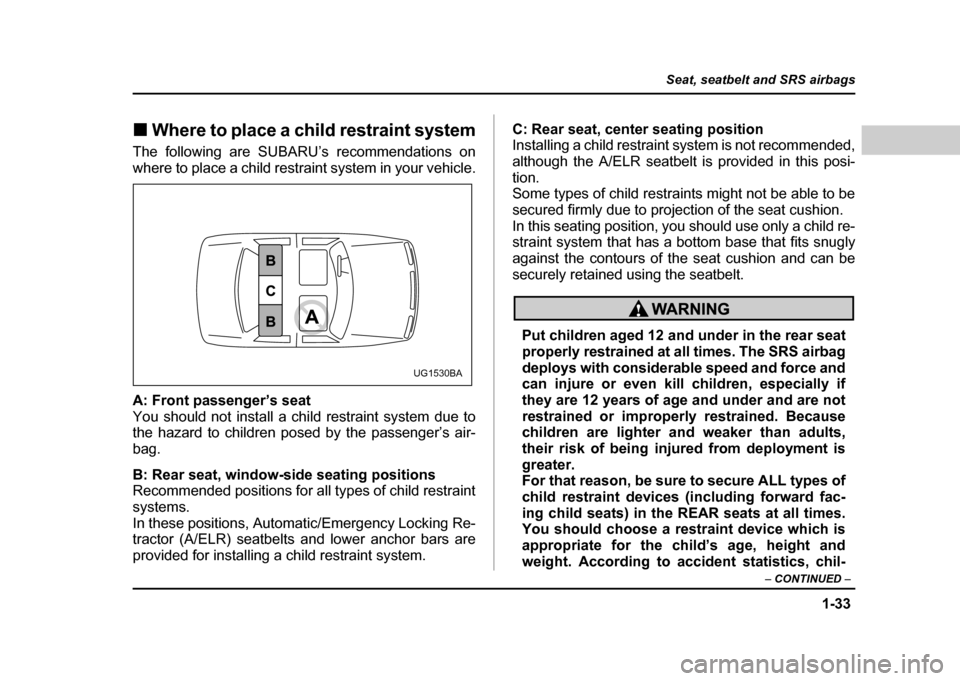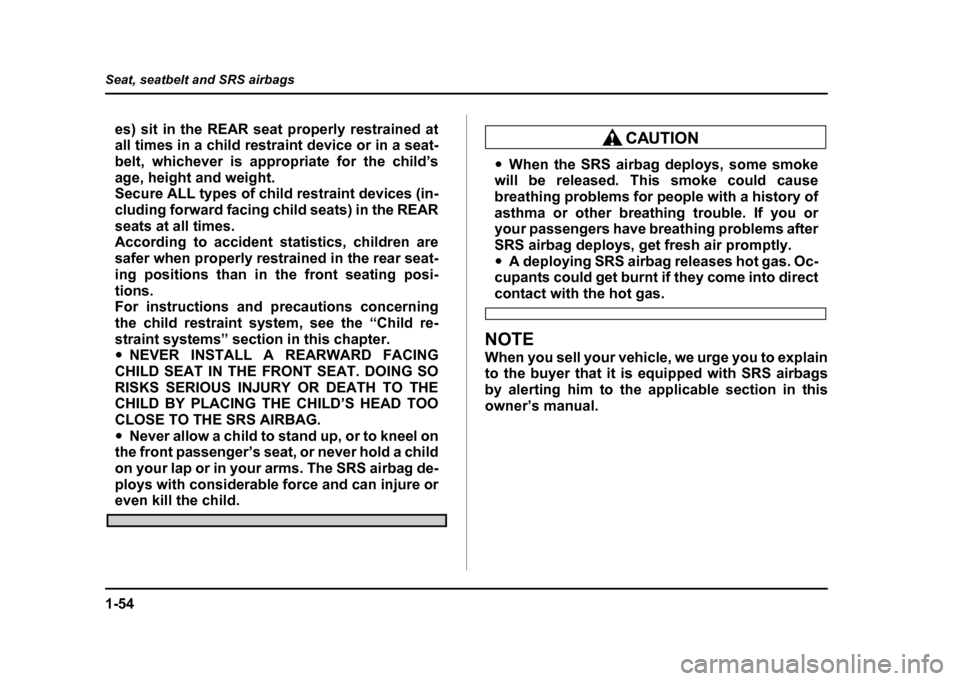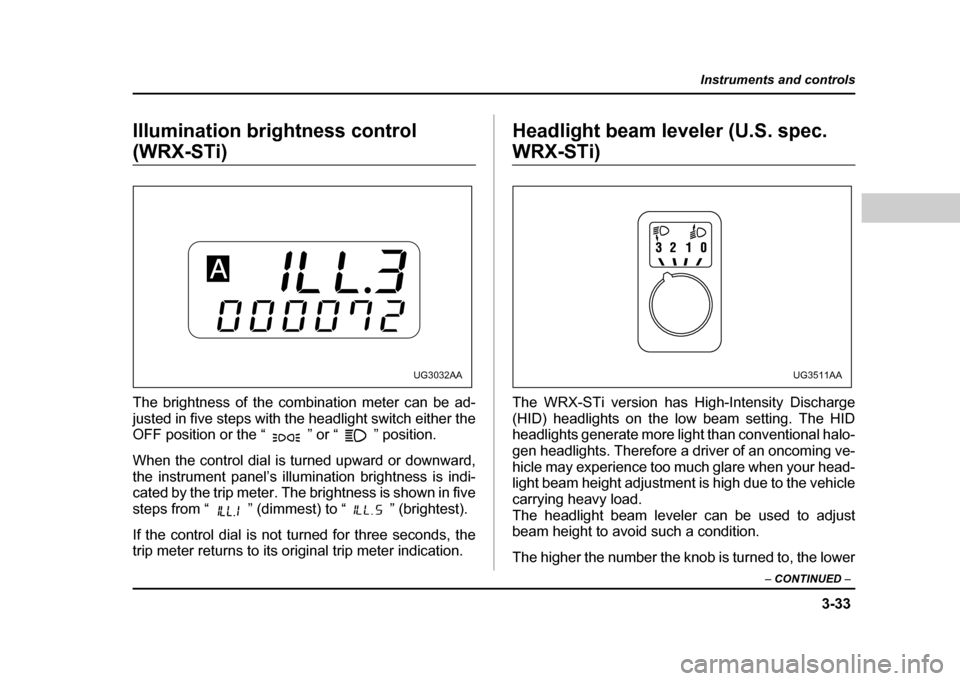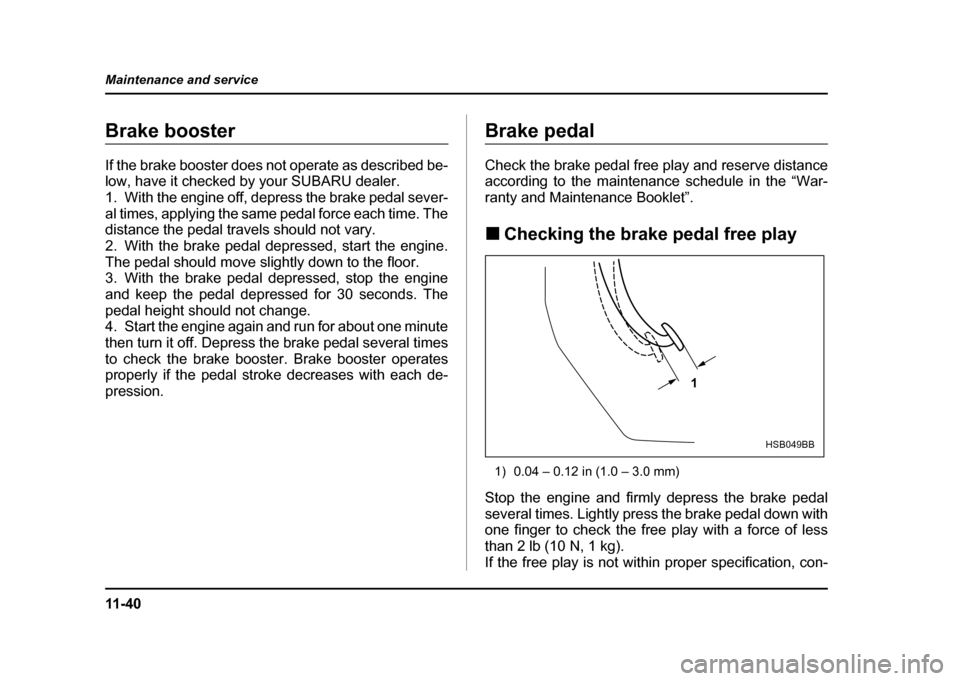Page 47 of 491
1-20
Seat, seatbelt and SRS airbags
"
Adjusting the rear seat shoulder belt anchor
height (window-side seating positions only)
The shoulder belt anchor height should be adjusted to
the position best suited for you. To adjust the anchor
height, push the release button and slide the anchor
up or down. Pull down on the anchor to make sure that
it is locked in place.
Always adjust the anchor height so that the shoulder
belt passes over the middle of the shoulder without
touching the neck.
When wearing the seatbelts, make sure the
shoulder portion of the webbing does not pass
over your neck. If it does, adjust the seatbelt an-
chor to a lower position. Placing the shoulder
belt over the neck may result in neck injury dur-
ing sudden braking or in a collision.
" Unfastening the seatbelt
Push the button on the buckle.
Before closing the door, make sure that the belts are
UG1075BA
HS1053BA
Page 60 of 491

1-33
Seat, seatbelt and SRS airbags
– CONTINUED –
!Where to place a child restraint system
The following are SUBARU’s recommendations on
where to place a child restraint system in your vehicle.
A: Front passenger’s seat
You should not install a child restraint system due to
the hazard to children posed by the passenger’s air-
bag.
B: Rear seat, window-side seating positions
Recommended positions for all types of child restraint systems.
In these positions, Automatic/Emergency Locking Re-
tractor (A/ELR) seatbelts and lower anchor bars are
provided for installing a child restraint system. C: Rear seat, center seating position
Installing a child restraint system is not recommended,
although the A/ELR seatbelt is provided in this posi-
tion.
Some types of child restraints might not be able to be
secured firmly due to projection of the seat cushion.
In this seating position, you should use only a child re-
straint system that has a bottom base that fits snugly
against the contours of the seat cushion and can be
securely retained using the seatbelt.
Put children aged 12 and under in the rear seat
properly restrained at all times. The SRS airbag
deploys with considerable speed and force and
can injure or even kill children, especially if
they are 12 years of age and under and are not
restrained or improperly restrained. Because
children are lighter and weaker than adults,
their risk of being injured from deployment is
greater.
For that reason, be sure to secure ALL types of
child restraint devices (including forward fac-
ing child seats) in the REAR seats at all times.
You should choose a restraint device which is
appropriate for the child’s age, height and
weight. According to accident statistics, chil-
UG1530BA
Page 61 of 491
1-34
Seat, seatbelt and SRS airbags
dren are safer when properly restrained in the
rear seating positions than in the front seating
positions.
SINCE YOUR VEHICLE IS EQUIPPED WITH A PASSENGER’S SRS AIRBAG, NEVER INSTALL
A REARWARD FACING CHILD SAFETY SEAT
IN THE FRONT PASSENGER’S SEAT. DOING SO RISKS SERIOUS INJURY OR DEATH TO
THE CHILD BY PLACING THE CHILD’S HEAD
TOO CLOSE TO THE SRS AIRBAG.
! Choosing a child restraint system
Choose a child restraint system that is appropriate for
the child’s age and size (weight and height) in order to
provide the child with proper protection. The child re-
straint system should meet all applicable requirements
of Federal Motor Vehicle Safety Standards for the
United States or of Canada Motor Vehicle Safety
Standards for Canada. It can be identified by looking
for the label on the child restraint system or the manu-
facturer’s statement of compliance in the document at-
HG1043BAUGS507AA
Page 81 of 491

1-54
Seat, seatbelt and SRS airbags
es) sit in the REAR seat properly restrained at
all times in a child restraint device or in a seat-
belt, whichever is appropriate for the child’s
age, height and weight.
Secure ALL types of child restraint devices (in-
cluding forward facing child seats) in the REAR
seats at all times.
According to accident statistics, children are
safer when properly restrained in the rear seat-
ing positions than in the front seating posi-
tions.
For instructions and precautions concerning
the child restraint system, see the “Child re-
straint systems” section in this chapter. "
NEVER INSTALL A REARWARD FACING
CHILD SEAT IN THE FRONT SEAT. DOING SO RISKS SERIOUS INJURY OR DEATH TO THE
CHILD BY PLACING THE CHILD’S HEAD TOO
CLOSE TO THE SRS AIRBAG." Never allow a child to stand up, or to kneel on
the front passenger’s seat, or never hold a child
on your lap or in your arms. The SRS airbag de-
ploys with considerable force and can injure or
even kill the child.
" When the SRS airbag deploys, some smoke
will be released. This smoke could cause
breathing problems for people with a history of
asthma or other breathing trouble. If you or
your passengers have breathing problems after
SRS airbag deploys, get fresh air promptly." A deploying SRS airbag releases hot gas. Oc-
cupants could get burnt if they come into direct
contact with the hot gas.
NOTE
When you sell your vehicle, we urge you to explain
to the buyer that it is equipped with SRS airbags
by alerting him to the applicable section in this
owner’s manual.
Page 170 of 491

3-33
Instruments and controls
– CONTINUED –
Illumination brightness control
(WRX-STi)
The brightness of the combination meter can be ad-
justed in five steps with the headlight switch either the
OFF position or the “ ” or “ ” position.
When the control dial is turned upward or downward,
the instrument panel’s illumination brightness is indi-
cated by the trip meter. The brightness is shown in five
steps from “ ” (dimmest) to “ ” (brightest).
If the control dial is not turned for three seconds, the
trip meter returns to its original trip meter indication. Headlight beam leveler (U.S. spec. WRX-STi)
The WRX-STi version has High-Intensity Discharge
(HID) headlights on the low beam setting. The HID
headlights generate more light than conventional halo-
gen headlights. Therefore a driver of an oncoming ve-
hicle may experience too much glare when your head-
light beam height adjustment is high due to the vehicle
carrying heavy load.
The headlight beam leveler can be used to adjust
beam height to avoid such a condition.
The higher the number the knob is turned to, the lower
UG3032AAUG3511AA
Page 344 of 491
8-33
Driving tips
– CONTINUED –
!Tongue load
Tongue load
Ensure that the trailer tongue load is from 8 to 11 per-
cent of the total trailer weight and does not exceed the
maximum value of 200 lbs (90 kg). 1) Jack
2) Bathroom scale
The tongue load can be weighed with a bathroom
scale as shown in the illustration below. When weigh-
ing the tongue load, be sure to position the towing cou-
pler at the height at which it would be during actual
towing, using a jack as shown.
HS8019AA
1 2
HS8020BB
Page 425 of 491

11 - 4 0
Maintenance and service
Brake booster
If the brake booster does not operate as described be-
low, have it checked by your SUBARU dealer.
1. With the engine off, depress the brake pedal sever-
al times, applying the same pedal force each time. The
distance the pedal travels should not vary.
2. With the brake pedal depressed, start the engine.
The pedal should move slightly down to the floor.
3. With the brake pedal depressed, stop the engine
and keep the pedal depressed for 30 seconds. The
pedal height should not change.
4. Start the engine again and run for about one minute
then turn it off. Depress the brake pedal several times
to check the brake booster. Brake booster operates
properly if the pedal stroke decreases with each de- pression.Brake pedal
Check the brake pedal free play and reserve distance
according to the maintenance schedule in the “War-
ranty and Maintenance Booklet”. !
Checking the brake pedal free play
1) 0.04 – 0.12 in (1.0 – 3.0 mm)
Stop the engine and firmly depress the brake pedal
several times. Lightly press the brake pedal down with
one finger to check the free play with a force of less
than 2 lb (10 N, 1 kg).
If the free play is not within proper specification, con-
1
HSB049BB
Page 467 of 491
12-2
Specifications
SpecificationsSpecifications
These specifications are subject to change without notice. !
Dimensions
in (mm)
*1: Measured with vehicle empty
AT: Automatic transmission
MT: Manual transmission
ItemSedanWagon
2.5-liter2.0-liter (Turbo)2.5-liter (Turbo)2.5-liter2.0-liter (Turbo)
RSWRXWRX-STiTSOUTBACK SPORTWRX
Drive systemAWD
Transmission typeATMTATMTMTATMTATMTATMT
Overall length173.8 (4415)
Overall widthSedan68.5 (1740)–
Wagon–66.7 (1695)67.3 (1710)66.7 (1695)
Overall heightWithout
roofrail56.7 (1440)56.3
(1430)57.7 (1465)58.1 (1475)57.7 (1465)
With roofrail–58.5 (1485)58.9 (1495)58.5 (1485)
Wheel base99.4 (2525)100
(2540)99.4 (2525)
TreadFront58.5 (1485)58.7
(1490)57.7 (1465)57.5 (1460)57.7 (1465)
Rear58.1 (1475)58.3 (1480)58.5
(1485)57.3 (1455)
Ground clearance *15.9 (150)6.1 (155)5.7 (145)5.9 (150)6.3 (160)6.1 (155)